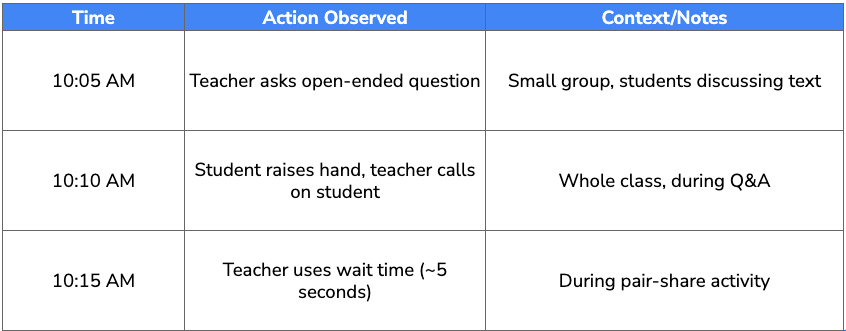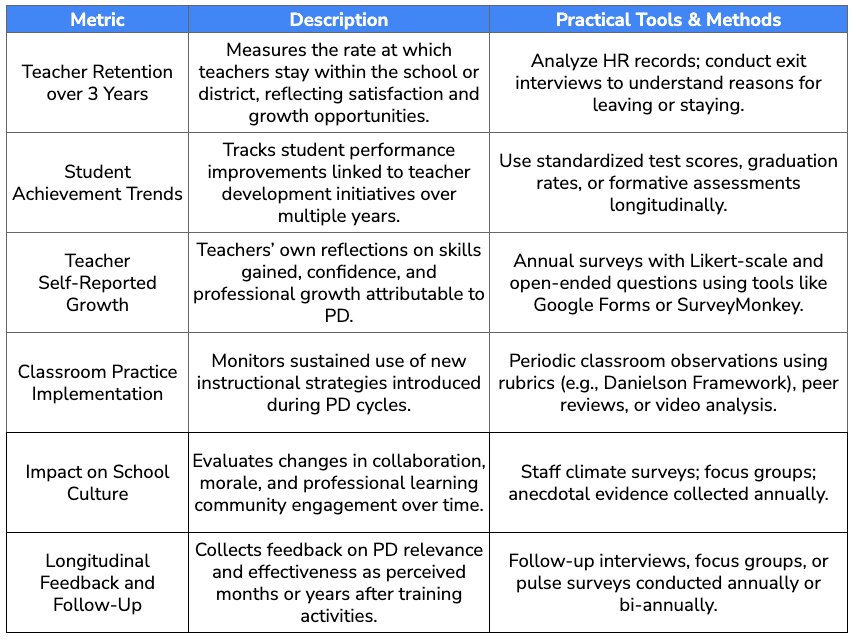Searching for a way to boost teacher performance and student outcomes? The coaching cycle is a powerful structured process designed to improve instructional practices and stimulate professional growth.
Jim Knight, a leading figure in instructional coaching and the Founder and Senior Partner of the Instructional Coaching Group (ICG), is widely recognized for popularizing and shaping the coaching cycle methodology.
This article breaks down the key phases and benefits of the coaching cycle, helping educators and coaches implement it effectively.
Key Takeaways
The coaching cycle is a structured process that includes pre-conference, coaching actions, and post-conference phases, which aim to increase teacher effectiveness and student learning through goal setting and continuous improvement.
Establishing clear, specific goals during the coaching process is important for effective classroom management, ensuring both coaches and teachers align their expectations and efforts for better student engagement and achievement.
Building strong relationships between coaches and teachers is essential for successful coaching cycles, as trust and open communication cultivates a collaborative environment that supports ongoing professional growth.
Understanding the Coaching Cycle
The coaching cycle is a structured process designed to set goals, develop strategies, monitor progress, and evaluate outcomes. Each of these phases represents a distinct stage in the coaching cycle, guiding teachers systematically through professional growth.
The primary purpose of this cycle is to stimulate professional development and continuous improvement, which can lead to significant growth in instructional practices and student learning.
Typically, instructional coaches play a pivotal role in this process, helping teachers identify clear, measurable goals and supporting them in implementing strategies to achieve these objectives.
Effective coaching cycles bridge the gap between theoretical learning and practical application, ensuring that new skills and strategies are effectively transferred to the classroom while working on the teacher’s reflection and implementation.
Reflection is a key component, encouraging teachers to analyze student data and adjust their approaches to learn for continuous improvement.
Adapting the Coaching Cycle for Diverse Settings
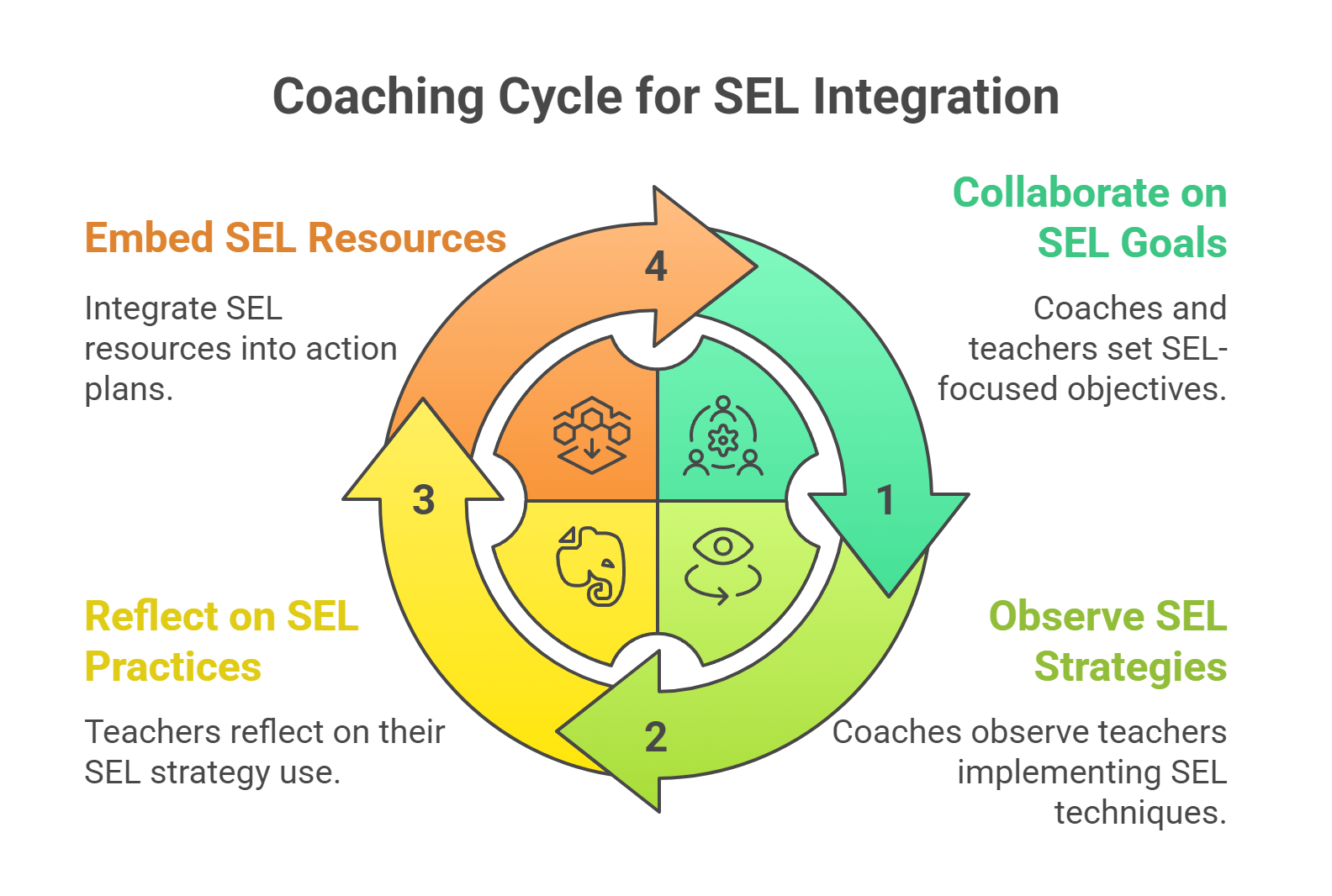
Coaching cycles are powerful tools for supporting teacher growth, but their impact is maximized when adapted thoughtfully to the unique contexts and various needs of educators and students.
Here’s how the coaching cycle can be tailored to fit different educational environments, ensuring relevance and effectiveness:
Prioritizing Social-Emotional Learning (SEL) in High-Needs Schools
In schools serving high-needs populations, where students may face trauma, stress, or social challenges, coaching cycles often emphasize SEL goals alongside academic instruction.
Coaches might:
Collaborate with teachers to set goals around creating safe, responsive classrooms that support student wellbeing.
Focus observations and reflections on teachers’ use of SEL strategies, like building relationships, emotional regulation techniques, and restorative practices.
Embed SEL-focused professional learning resources into action plans, helping teachers integrate these approaches naturally into their instruction.
This adaptation recognizes that supporting students’ social and emotional needs is foundational to academic success in these contexts.
Using Bilingual and Multilingual Resources for Diverse Classrooms
In multilingual or English language learner (ELL)-rich classrooms, coaching cycles can incorporate culturally responsive and language-accessible materials:
Goal-setting conversations include objectives targeting differentiated instruction for ELLs and language development support.
Coaches provide or model strategies that leverage students’ native languages as assets, scaffold content language, or use visual and interactive methods.
Resources and feedback are offered in multiple languages where possible, or include translation support to ensure equity in coaching access.
Virtual coaching sessions may utilize captioning or bilingual facilitators to bridge language barriers.
Flexibility in Cycle Pacing and Delivery
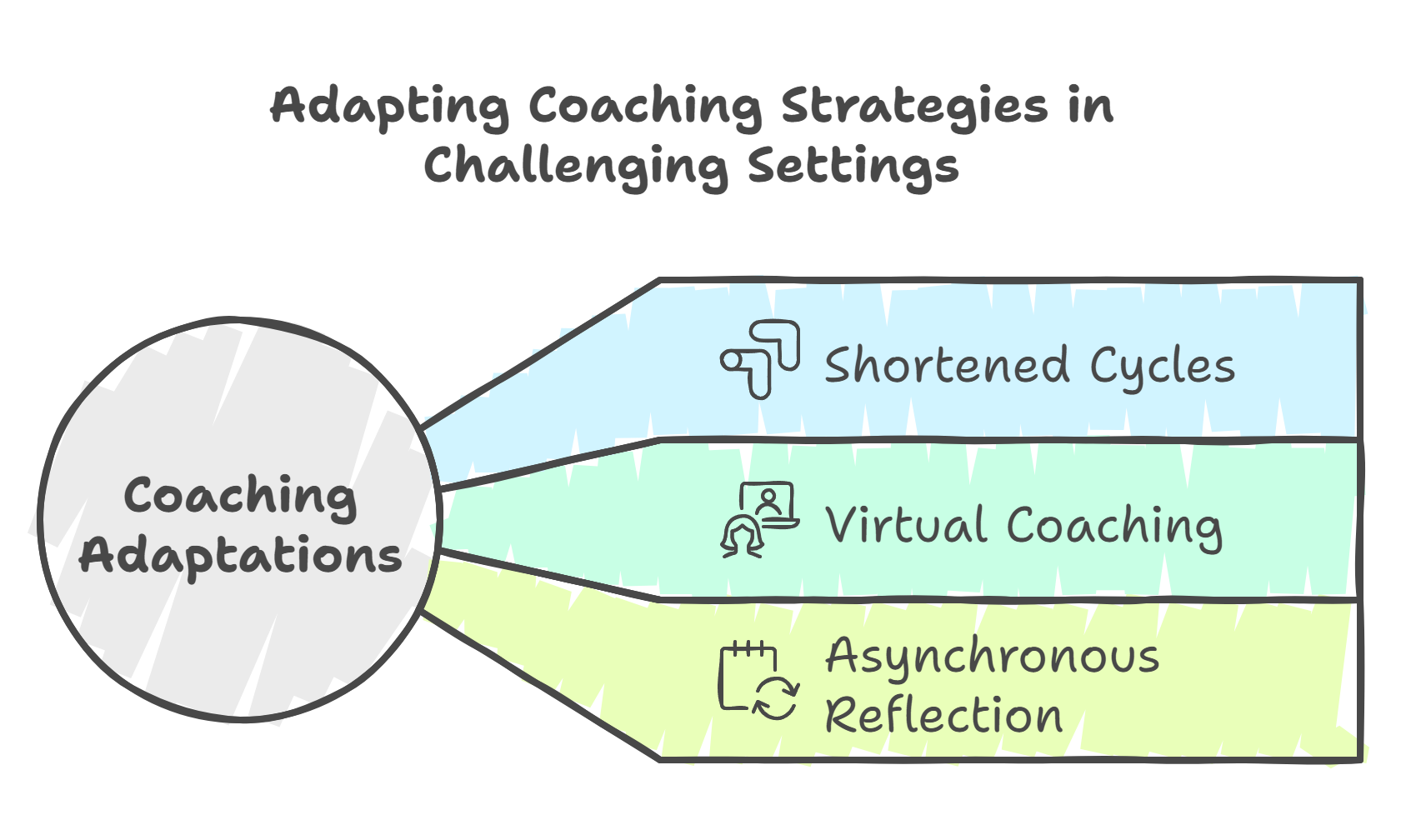
In rural, under-resourced, or time-constrained settings, adaptations might include:
Shortening cycles or focusing on fewer goals per cycle to accommodate limited coaching time.
Using virtual coaching meetings to reduce travel burdens.
Creating asynchronous reflection tasks and video exchanges when in-person observations are difficult.
Culturally Responsive Coaching Practices
Coaches adapt their stance and communication styles to honor the cultural identities of teachers and students, asking reflective questions that surface cultural assumptions and making space for individualized goal setting aligned with cultural values and community contexts.
Adapting the coaching cycle means carefully mixing contextual awareness and cultural responsiveness together with flexible delivery methods to ensure all teachers, whether in high-needs urban schools, multilingual classrooms, rural districts, or culturally diverse communities, receive meaningful, relevant support.
Tailoring coaching to the specific needs of teachers and their students in this way may promote ongoing traditional education development and a lasting positive impact, serving as a model for effective student work practices.
Key Phases of the Coaching Cycle
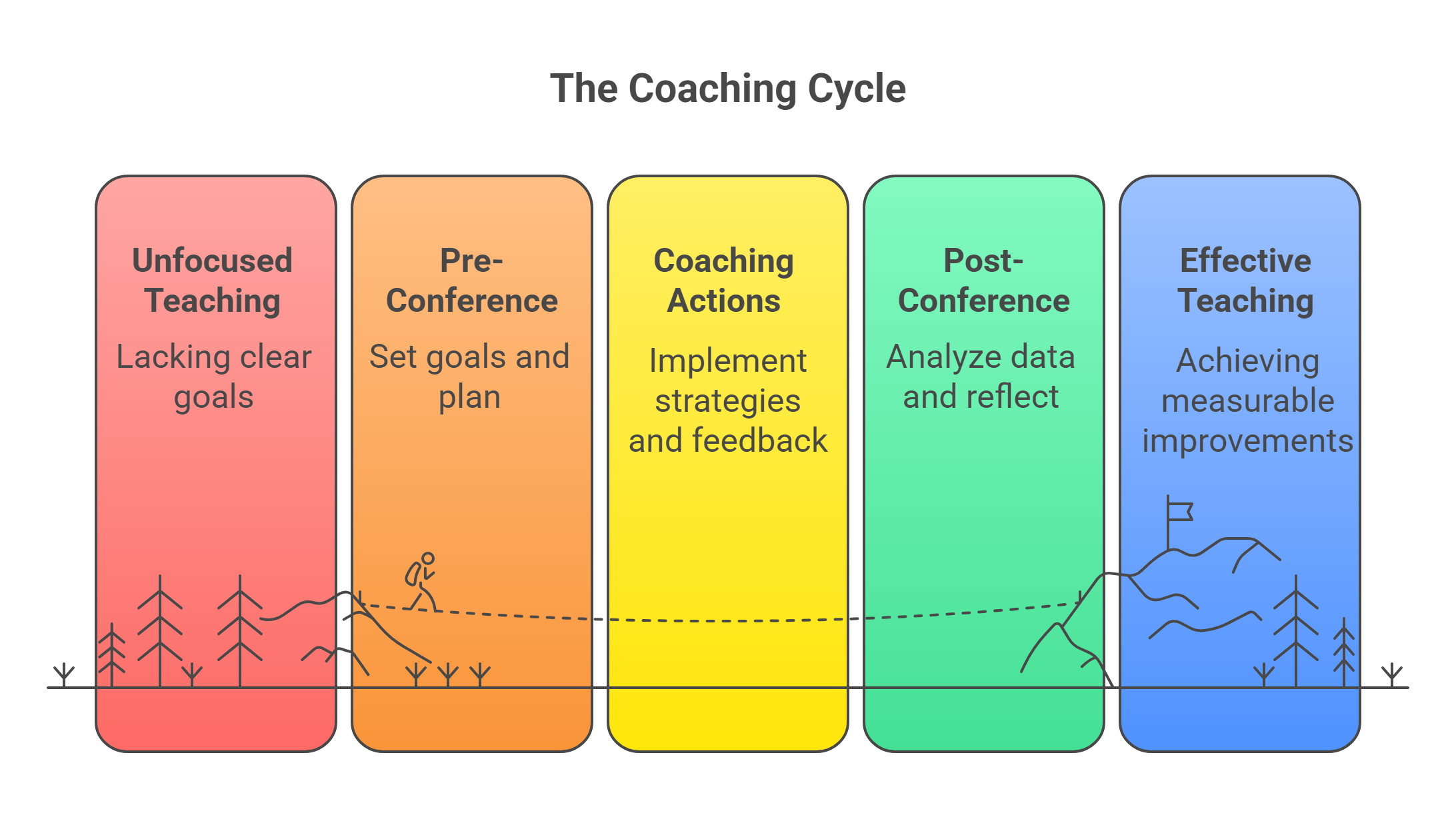
The coaching cycle consists of three main phases: Pre-Conference, Coaching Actions, and Post-Conference. Each phase plays an important role in the overall success of the coaching process, ensuring that goals are set, strategies are implemented, and outcomes are evaluated.
In the Pre-Conference phase, the instructional coach and teacher:
Meet to discuss goals and concerns.
Set specific, measurable goals.
Plan steps to achieve these goals, focusing on areas for improvement.
Design an action plan that suits the teacher’s needs and the classroom’s challenges.
In the Coaching Actions phase, the coach and teacher engage in activities such as:
Co-teaching,
Modeling,
Observation,
Co-planning.
Immediate feedback during this phase enables teachers to make timely corrections, improving the learning experience for both teachers and students. Effective time allocation is essential to ensure deep engagement and learning throughout this phase.
Finally, the Post-Conference phase involves:
Analyzing the data collected.
Providing evidence-based feedback.
Reflecting on the overall process to identify areas for further improvement and future goals.
Example Scenarios
To help bring the coaching cycle to life, here are practical examples illustrating how each phase might play out in real educator-coach interactions.
1. Goal-Setting Conversation (Pre-Observation Phase)
The coach and teacher meet to clarify focus and set clear goals. The conversation might look like this:
Coach: “What aspect of your instruction do you want to explore or improve this cycle?”
Teacher: “I want to strengthen student engagement during group discussions, especially getting quieter students to participate.”
Coach: “Great focus. Let’s set a goal: ‘Increase participation of all students in small group discussions by using targeted questioning techniques.’ How will you know it’s working?”
Teacher: “I’ll track participation rates and note which strategies prompt more contributions.”
Coach: “Excellent. We’ll plan to observe a lesson where you facilitate a group discussion and collect evidence on your questioning.”
2. Co-Teaching Activity (Observation/Coaching Phase)
The coach models a group discussion technique during a co-taught lesson. The coach demonstrates how to use open-ended, equity-focused questions that encourage every student to share ideas.
For example:
Coach: “I notice some students haven’t spoken yet. Let’s try, ‘What do others think about this idea?’ to invite more voices.”
The teacher practices this technique with support, while the coach observes and provides gentle prompts.
Afterward, they discuss what worked well and identify moments where the strategy could improve.
3. Feedback Session Outline (Post-Observation/Reflection Phase)
The coach provides targeted, constructive feedback following the observation.
Coach: “I noticed you paused effectively to give students time to think before responding, which encouraged deeper answers, great job.”
Teacher: “Thanks! I was worried about the timing.”
Coach: “One area to try next is explicitly inviting quieter students to contribute by using name prompts or think-pair-share. How comfortable are you with trying that?”
Teacher: “I feel ready to give it a shot.”
Coach: “Let’s set that as your next step. I’ll support you with resources and follow up in our next cycle.”
These examples illustrate how the coaching cycle flows through collaborative dialogue, active skill modeling, and reflective feedback, all designed to monitor professional growth and improved classroom practice.
Importance of Goal Setting
Goal setting is a critical component of the coaching process, as it provides a clear focus and direction for both the coach and the teacher. Establishing specific, measurable behavior goals helps teachers align their expectations with overall classroom management objectives, leading to better accountability and a more structured learning environment.
Setting clear, specific goals helps teachers outline their expectations and create a roadmap for success. This approach ensures coaching efforts lead to measurable, positive outcomes, facilitates better planning, and improves student engagement and student achievement.
Implementing Classroom Management Strategies
Effective classroom management is essential for creating an environment conducive to learning. Coaching cycles emphasize empowering teachers to take charge of classroom management through data-driven strategies.
Focusing on specific goals and using evidence-based practices helps student engagement and achievement, leading to a more productive and positive classroom atmosphere.
Instructional coaching supports teachers in implementing these strategies by providing personalized guidance and feedback. This way, teachers address their unique challenges and develop the skills needed to maintain order and foster a supportive learning environment.
The following sections will explore further the processes of establishing behavior goals and collecting data to track progress and get results well.
Establishing Behavior Goals
Establishing clear and specific behavior goals is also a key step in aligning instructional practices with overarching educational visions. Collaborative goal setting between coaches and teachers increases ownership of the learning environment and ensures that both parties are committed to achieving the desired outcomes.
Identifying specific goals during the pre-conference phase allows teachers to focus on addressing particular challenges and improving classroom management.
The goals set during this phase guide the subsequent coaching actions, allowing for personalized support and targeted interventions.
Clear and specific behavior goals contribute to the effectiveness of classroom management strategies, helping teachers create a structured and positive learning environment.
Data Collection Methods
Using various data collection methods is essential for tracking student behavior and engagement effectively. One such method is low-inference notes, which involve recording observations without interpreting behavior, allowing for an unbiased account of student actions.
Real-world applications of coaching cycles demonstrate that structured data collection enhances teacher effectiveness and student engagement.
Tracking specific behavior incidents and analyzing trends enables teachers to develop targeted strategies to improve student behavior and overall classroom management.
Practical Data Collection Tools
Collecting accurate and meaningful data during coaching cycles is essential for tracking growth, informing feedback, and planning next steps. Below are practical tools and templates that make data collection more efficient and actionable for instructional coaches.
1. Low-Inference Note Template
This is a simple observational template designed to capture objective data with minimal interpretation. It helps coaches record concrete behaviors, actions, and contexts without subjective judgment, providing clear evidence to guide discussions.
How to use:
Record the time or interval for each noted action.
Describe what the teacher or students are doing precisely (low inference).
Add brief context to clarify where or when it occurred.
This template can be printed or used digitally (e.g., a shared Google Doc or spreadsheet) to facilitate quick, consistent note-taking.
2. Free Digital Tools for Data Collection
Google Forms: Create customizable forms for tracking specific behaviors, coaching topics, or teacher reflections. For example, use a form to document behavior incidents, coaching session notes, or teacher self-assessments.
Google Sheets: Ideal for organizing, sorting, and visualizing collected data. Multiple coaches can collaborate in real time, and you can create charts or dashboards linked to Google Forms submissions for quick insight.
Trello or Asana: Use these project management tools for tracking coaching cycles, setting goals, and recording observational notes tagged by date or topic. Their collaborative features allow coaches and teachers to stay aligned on progress.
Microsoft’s OneNote or Google’s KeepNote: Useful for quick note-taking during observations with the ability to organize notes by teacher, date, or focus area and attach photos or audio clips if relevant.
3. Sample Use Case: Tracking Behavior Incidents
Develop a simple Google Form with fields like:
Date and Time.
Type of Behavior (e.g., off-task, disruptive, engagement).
Location (e.g., small group, whole class).
Teacher Response.
Outcome/Notes.
This form can be completed on a mobile device immediately and automatically compiles data to identify trends and inform coaching discussions.
The Role of Observation and Feedback
Observation and feedback are critical components of the coaching cycle, as they provide valuable insights into teaching practices and support continuous improvement.
The observation phase focuses on identifying and supporting the unique needs of teachers rather than judging their performance. Effective coaching relies on gathering data about teacher practices through observation, which can then be used to provide actionable feedback.
The following sections will explore effective observation techniques and how to provide constructive feedback that encourages reflection and improvement.
Effective Observation Techniques
Effective observation techniques are crucial for gathering relevant data during the coaching cycle. Co-teaching, where both the coach and the teacher deliver instruction together, encourages teamwork and immediate feedback.
Observational formats such as mentor observations and video recordings can improve the observation process by allowing for reflection and review.
Using video recordings for lesson observations is a key strategy in improving classroom management, enabling feedback to be provided flexibly.
Tracking specific behavior incidents and using data points such as office discipline referrals can inform targeted interventions and improve student behavior.
The Use of Technology in Coaching
Incorporating technology into observation practices is transforming how instructional coaches and teachers collaborate, making coaching more accessible, data-driven, and personalized.
Here are some important tools and ways to leverage technology effectively within coaching cycles:
1. Virtual Observations with Zoom and Other Video Platforms
Especially important in remote or hybrid settings, platforms like Zoom allow coaches to observe live lessons or review recorded sessions without being physically present.
Features such as screen sharing, breakout rooms, and session recording enable detailed examination of classroom interactions and instructional strategies. Coaches can pause, rewind, and annotate recordings for improved feedback discussions.
2. Talk-Time Analysis with TeachFX
TeachFX is an innovative AI-powered tool that analyzes classroom audio recordings to provide objective data on teacher and student talk time.
It helps coaches and teachers identify patterns like teacher dominance or student engagement, facilitating targeted feedback to balance interactions and encourage active learning.
Best Practices for Using Technology in Coaching
Ensure all participants have reliable internet access and basic training on the tools to ensure smooth technology integration.
Address privacy and consent by securing permissions and using encrypted platforms when recording or sharing classroom lessons.
Combine technological data with human judgment; AI and digital tools provide insights, but coaching remains a relational and reflective process.
Use technology to complement, not replace, in-person observations and personal interactions whenever possible.
A skillful use of these technologies within the coaching cycle, can help coaches improve the precision of observation, the quality of feedback, and even increase the reach of impactful professional development.
Providing Constructive Feedback
Providing constructive feedback is essential for helping teachers reflect on their practices and make necessary adjustments.
Feedback should be actionable and based on evidence, encouraging teachers to engage in reflective practice and improve their instructional methods. Descriptive feedback that includes specific examples improves understanding and helps with improvement, leading to enhanced teaching effectiveness.
Instructional coaches are not left out as they play an important role in delivering this feedback, supporting teachers in their professional development and ensuring that the coaching process leads to continuous improvement.
Overcoming Challenges in the Coaching Cycle
The coaching cycle is not without its challenges. One of the main obstacles is that it can be a time-intensive process requiring significant commitment from both coaches and teachers.
Additionally, teacher resistance is a common challenge, often stemming from a fear of criticism or being judged in traditional coaching.
Traditional coaching often involves evaluative feedback without including sustained growth, which can further contribute to resistance and limit its long-term effectiveness.
Effective coaching requires addressing these challenges head-on by encouraging a supportive environment. Regularly revisiting goals and strategies is important for long-term effectiveness, ensuring that the coaching process remains focused and impactful.
In traditional coaching, feedback may not lead to systematic teacher growth post professional development sessions, highlighting the importance of a structured and reflective coaching cycle for sustained improvement.
The following sections will discuss strategies for addressing teacher resistance and managing time effectively during the coaching cycle.
Addressing Teacher Resistance
Teacher resistance can be a significant hurdle in the coaching cycle. It often arises from a fear of criticism or being judged. Establishing a trusting relationship and ensuring a supportive environment can mitigate this resistance.
A collaborative coaching environment helps teachers’ willingness to embrace change and engage in the coaching process.
Practical Strategies for Building Trust
Building trust with teachers is a foundational step in overcoming resistance to professional development. When teachers feel valued and respected, they are more open to trying new strategies and engaging in growth.
Below are concrete, actionable strategies to build trust in PD contexts:
1. Host a Workshop on Growth Mindset
Organize an interactive session focusing on the principles of growth mindset, emphasizing that skills and teaching effectiveness develop over time with effort and reflection.
Include activities where teachers reflect on past challenges and successes, normalizing setbacks as learning opportunities.
Use real-life educator stories to model persistence and progress.
2. Facilitate Reflective Questioning Protocols
Use guided reflective questions during coaching sessions or PD meetings to invite teachers to explore their own experiences and challenges without judgment.
Sample protocol questions:
“What challenges do you face in implementing this strategy?”
“What has worked well for you so far, and why?”
“How do you think your students respond to this approach?”
“What support do you feel you need to overcome obstacles?”
These open-ended questions communicate respect for teachers’ expertise, encourage self-assessment, and build collaborative problem-solving.
3. Develop Collaborative Decision-Making
Involve teachers in designing PD activities, selecting topics, and setting goals. Feeling ownership increases buy-in.
Use surveys or small-group discussions to surface their interests and concerns, then incorporate their input into planning.
Transparency about decision processes nurtures trust by showing that leadership values teacher voices.
4. Create Safe, Non-Evaluative Learning Spaces
Emphasize that PD sessions and coaching are spaces for experimentation and growth, not formal evaluations.
Set norms around confidentiality, respect, and constructive feedback to alleviate anxiety.
5. Build Relationships Through Informal Interactions
Encourage leaders and coaches to spend time with teachers outside formal PD, such as coffee chats or casual check-ins, to build rapport and authenticity.
Personal connections humanize the process and soften resistance born from impersonal mandates.
Integrating these trust-building activities and protocols into professional development design and delivery enables schools to create nurturing environments where teachers feel empowered.
Time Management
Time management is another critical challenge in the coaching cycle. Having realistic expectations of progress by the end of the coaching cycle is crucial for effective goal setting.
A supportive coaching process helps teachers develop a growth mindset, enabling them to manage their time effectively and focus on achieving their goals.
Instructional coaches can assist by providing practical strategies for managing time and resources, ensuring that the coaching process remains focused and productive.
Prioritizing tasks and allocating adequate time for each phase of the coaching cycle enables coaches and teachers to achieve meaningful and lasting improvements together.
Best Practices for Sustained Success
Ensuring the long-term success of the coaching cycle requires implementing best practices that support continuous improvement and development.
Key insights from coaching case studies include:
Starting small and gradually scaling up the coaching process to ensure sustainable development.
Using structured cycles to lead to improved classroom practices and increased student engagement.
Providing ongoing support and follow-up sessions to maintain progress.
Training and preparation for instructional coaches are fundamental factors for success, as practical experience alone is insufficient without proper training.
Focusing on high-quality coaching practices and providing continuous professional development enables schools to achieve lasting improvements in teaching and learning.
Scaling the Coaching Cycle
To extend the positive impact of coaching beyond individual teachers and classrooms, scaling the coaching cycle strategically is essential. This ensures that effective practices spread across schools and districts, enabling a culture of continuous professional growth and improved student outcomes.
Here are key steps to successfully scale the coaching cycle:
Develop a Comprehensive Coach Training Program
Design and implement a structured coach training curriculum, such as a 6-week intensive program, that prepares new coaches with foundational skills in observation, feedback, data collection, and adult learning.
Training should include practice cycles, role plays, and reflection to build confidence and consistency.
Align Coaching Goals with District Priorities
Ensure coaching objectives clearly support broader district or school improvement plans, such as literacy advancement, SEL integration, or technology adoption. Alignment guarantees that coaching efforts contribute directly to measurable goals valued by leadership and stakeholders.
Create a Coaching Cadre or Network
Build a community of trained coaches who meet regularly to share insights, troubleshoot challenges, and refine their practice. A coaching network promotes peer learning, sustains motivation, and encourages fidelity to the coaching model.
Use Data to Inform Expansion
Monitor key performance indicators (e.g., teacher growth, student outcomes) to identify where coaching has the greatest impact and where additional support is needed. Data-driven decision-making facilitates targeted scaling and resource allocation.
Leverage Technology for Wider Reach
Incorporate virtual coaching platforms, video observations, and AI tools to extend coaching access to educators in remote or underserved areas. Technology can also support asynchronous coaching conversations and resource sharing across large districts.
Institutionalize Coaching in Professional Development Systems
Integrate coaching cycles into regular PD schedules, evaluation processes, and school leadership routines. Embedding coaching in the system ensures sustainability beyond pilot phases and funding cycles.
Communicate Impact and Celebrate Successes
Share stories, data highlights, and testimonials from coaching participants to build buy-in among educators, administrators, and policymakers. Celebrating successes reinforces commitment and supports continued investment.
Scaling the coaching cycle through these deliberate steps, provides the opportunity for districts and schools to amplify professional learning and boost student achievement at scale.
Building Strong Coach-Teacher Relationships
Building strong relationships between coaches and teachers is essential for a productive coaching cycle. Trust and open communication cultivate a positive environment and strengthen the partnership between coaches and teachers.
Non-judgmental language in feedback encourages teacher candidates to engage in self-assessment and reflection.
Continuous Professional Learning
Ongoing professional development should include reflective practices to enhance teaching effectiveness. Engaging in collaborative learning communities encourages professional growth among educators.
Post-conference reflections often use various types of evidence, such as student surveys and assessment data, to evaluate outcomes and inform future practices.
Measuring Long-Term Impact
Sustained professional growth relies not only on ongoing learning but also on tracking its long-term effects to ensure continuous improvement and meaningful outcomes for educators and students.
Here are key metrics and practical tools to measure the lasting impact of continuous professional learning:
Tips for Measuring Long-Term Impact:
Establish a baseline before PD begins to compare future data effectively.
Incorporate multiple data sources, such as quantitative scores, qualitative feedback, and observational data, to gain a holistic view.
Use digital tools like Google Forms for easy survey distribution and data aggregation.
Schedule annual or bi-annual reviews to track progress and adjust PD offerings accordingly.
Engage leadership and teachers in reviewing data to foster a culture of shared responsibility for continuous improvement.
Align metrics with broader organizational or district goals to demonstrate relevance and secure ongoing support.
A methodical approach to measuring these long-term indicators, allows schools and districts to ensure that professional learning translates into tangible benefits, sustains teacher development and improves student success.
Summary
In conclusion, mastering the coaching cycle involves understanding its key phases, the importance of goal setting, and effective classroom management strategies.
Observation and feedback also play crucial roles in supporting teacher growth and improving instructional practices. Overcoming challenges such as teacher resistance and time management is essential for the success of the coaching process.
Implementing best practices and focusing on continuous professional learning ensures that coaching efforts lead to sustained success and lasting improvements.
Frequently Asked Questions
What are the main phases of the coaching cycle?
The coaching cycle mainly consists of Pre-Conference, Coaching Actions, and Post-Conference. Each phase is essential for setting goals, putting strategies into action, and assessing results.
Why is goal setting important in the coaching cycle?
Goal setting is crucial in the coaching cycle because it gives both the coach and the teacher a clear focus, which boosts planning and accountability.
How can teachers overcome resistance to coaching?
Building trust and promoting a collaborative environment are key to overcoming resistance to coaching. When teachers feel supported and open, they’re more likely to embrace the process.
What are effective observation techniques in the coaching cycle?
To help your coaching cycle, consider using co-teaching, video recordings, and mentor observations. These techniques not only gather valuable data but also pave the way for meaningful feedback.
How does continuous professional learning contribute to the success of the coaching cycle?
Continuous professional learning significantly boosts the success of the coaching cycle by cultivating reflective practices and collaborative learning.

